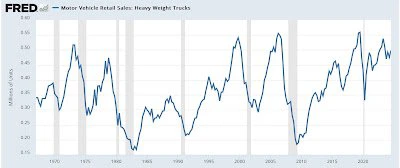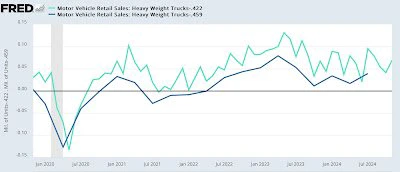Heavyweight trucks typically show a decline of 10% or more prior to a recession.
Truck sales raise a red flag
– authored by New Deal democrat
Two decades back, Professor Edward Leamer garnered significant attention with a presentation to the Federal Reserve, declaring that “Housing IS the Business Cycle.” He emphasized the correlation between declines in the housing market and the onset of recessions, typically occurring about seven quarters later. However, for the current discussion, I would like to zero in on his conclusion that following a downturn in housing, the subsequent sector to experience a decline was business spending on durable goods.
A reliable indicator of business investment in durable goods historically has been the acquisition of heavy-duty trucks. Although sales figures for cars and light trucks can fluctuate significantly, heavy-duty truck sales have consistently shown a tendency to decline by -10% or more ahead of economic downturns, with the only exception being in 1970 (as illustrated in the quarterly averages in the graph below):

View pictures in App save up to 80% data.
This naturally leads me to discuss the most recent data. It seems that FRED delays updating their graph for a few weeks after the BEA releases the information. To give you the latest figures, in December, the seasonally adjusted sales of heavy trucks stood at 0.422 million annualized (represented by the light blue line in the graph below). For the fourth quarter, the average sales were 0.459 million (depicted in dark blue). As illustrated in the graph below, which normalizes both figures to zero, these numbers represent the lowest sales figures seen in the past two and a half years.

View pictures in App save up to 80% data.
Now, let's incorporate Prof. Leamer's framework into our analysis. Below, I present the complete timeline of housing permits (depicted in red on the left scale) compared to heavy-duty truck sales (illustrated in blue on the right scale):

View pictures in App s